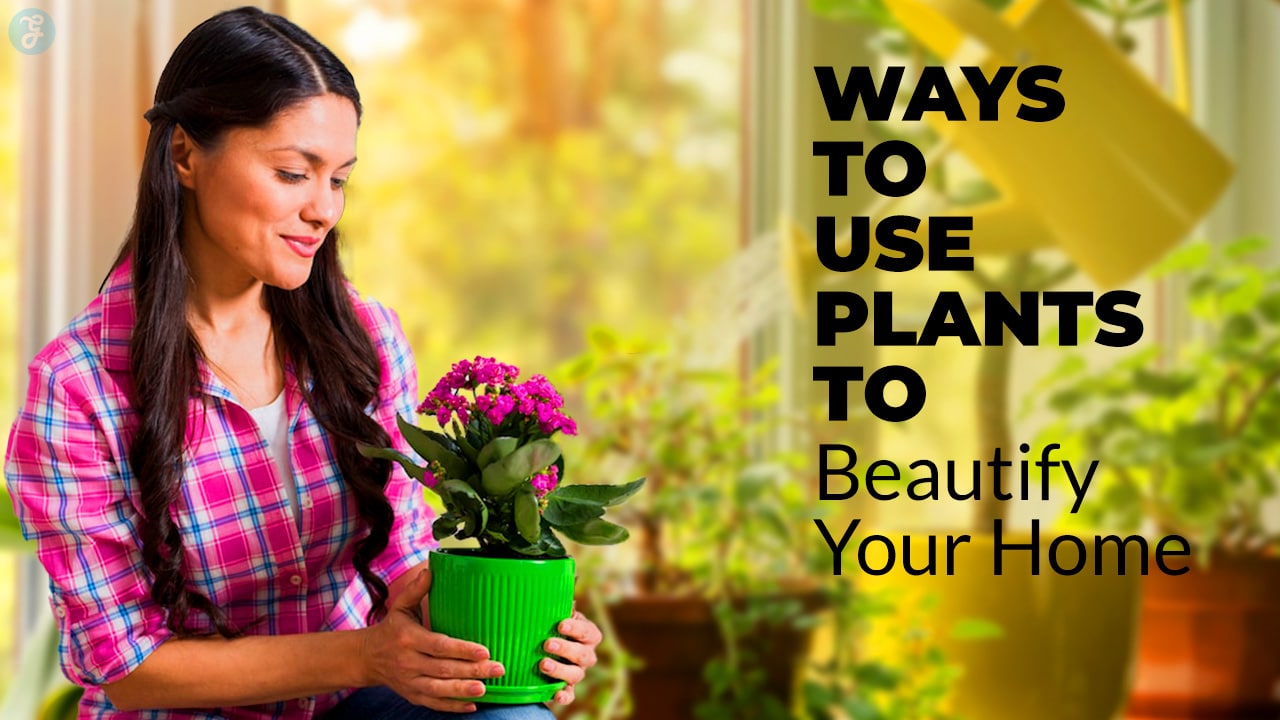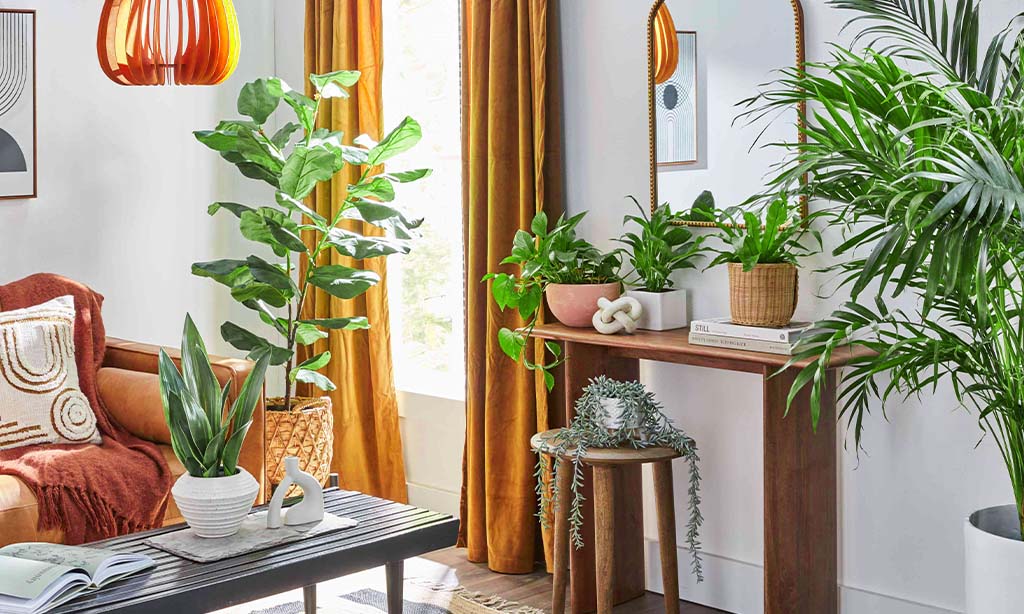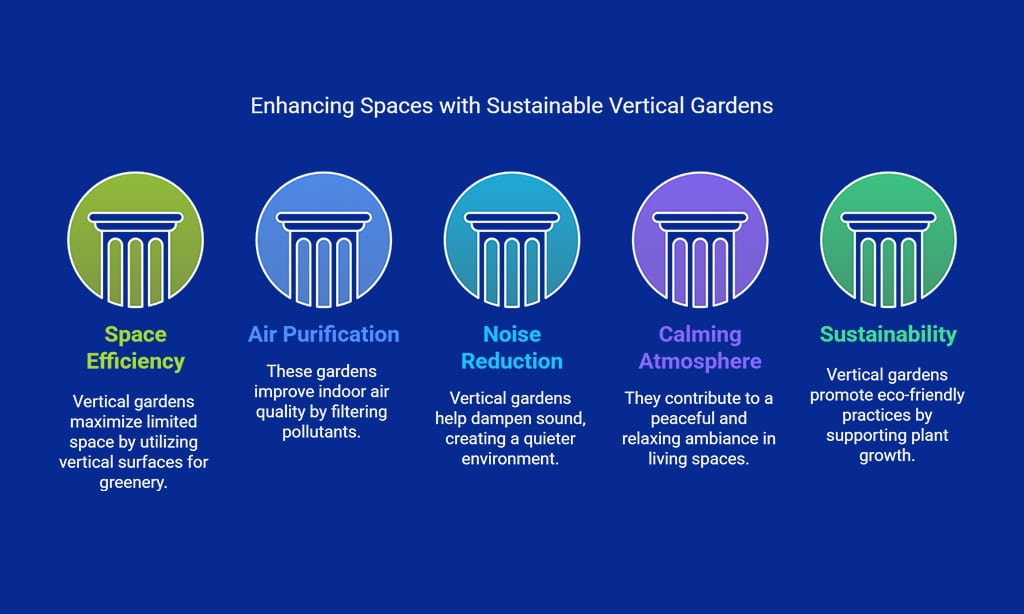Plants are more than just decorative elements in a home; they’re a gateway to a healthier, more vibrant living environment. In this article, we’ll explore 10 ways to use plants to beautify your home, showing how even a few well-placed green additions can transform a room.
Whether you’re a seasoned plant lover or a beginner, these practical tips will guide you in creating spaces that feel both fresh and inviting.
Why Plants Are Essential for Home Décor?
Incorporating plants into your home décor does more than simply enhance aesthetics—it improves your health, mood, and overall well-being. According to research, indoor plants can purify the air by removing toxins and releasing oxygen, contributing to better air quality and a more comfortable living environment.
Plants also offer psychological benefits, such as reduced stress levels and increased feelings of calm. By blending functionality with beauty, plants serve as living, breathing décor that nurtures both mind and body.
The Benefits of Adding Plants to Your Living Space
Adding plants to your living space can offer more than just visual appeal. Studies have shown that plants help reduce stress, improve concentration, and boost creativity. Moreover, they contribute to better humidity levels and can even help with noise reduction.
A study from NASA’s Clean Air Study highlights that certain houseplants can filter out common indoor pollutants, making your space healthier. By understanding these benefits, you can fully appreciate the value plants bring to your home, both as décor and as functional additions.
Let’s explore the 10 ways to use plants to beautify your home in detail, ensuring you can maximize the potential of greenery in your living spaces.
1. Choose the Right Plants for Each Room
When choosing plants for different areas in your home, it’s important to consider factors like light levels, humidity, and temperature. Certain plants thrive in bright, sunny spots, while others flourish in low-light areas. Additionally, some plants require more humidity than others, so it’s essential to match the right plant to the right conditions.
Key Considerations:
| Factor | Considerations |
| Light | Bright light plants: Succulents, Fiddle Leaf Fig. Low light plants: Snake Plant, ZZ Plant. |
| Humidity | High humidity: Ferns, Calatheas. Low humidity: Cacti, Succulents. |
| Temperature | Warm environments: Rubber Plant, Croton. Cooler environments: Peace Lily, Spider Plant. |
Best Plants for Living Rooms, Bedrooms, and Kitchens
- Living Room: Large, statement plants like the Fiddle Leaf Fig or Rubber Plant can add a bold and sophisticated touch to your space. They also draw attention to empty corners or help define the space.
- Bedroom: Peace lilies, Lavender, and Aloe Vera can improve air quality while promoting restful sleep.
- Kitchen: Fresh herbs like Basil, Mint, and Rosemary not only contribute to cooking but also add a pleasant fragrance.
Practical Example:
In a recent design project, a client used a large Fiddle Leaf Fig in their living room to complement modern furniture and natural wood accents. The plant helped bring the room together by adding height and a natural focal point, enhancing the overall ambiance.
2. Create a Green Corner with Indoor Plants
A green corner is a beautiful, low-maintenance way to infuse nature into your home without overwhelming it. Choose an underutilized corner, preferably with access to natural light, and arrange a variety of plants in different sizes. Use plant stands, floating shelves, or macramé hangers to elevate your plants and add depth.
Key Tips for Design:
- Group plants in clusters with different heights to create a layered effect.
- Include plants with varying leaf textures and colors to enhance the visual appeal.
- Add a comfortable chair or small bench to complete the green oasis.
Popular Indoor Plants for a Stylish Corner
Here are some plant suggestions for your green corner:
| Plant | Benefits | Maintenance |
| Fiddle Leaf Fig | Adds height and drama to the corner. | Moderate sunlight and watering. |
| Snake Plant | Excellent air purifier, low-maintenance. | Tolerates low light and irregular watering. |
| Monstera Deliciosa | Adds tropical appeal with dramatic leaves. | Thrives in bright, indirect light. |
Practical Example:
In a recent project in a New York apartment, a client created a cozy green corner with a Monstera Deliciosa surrounded by smaller plants like Pothos and Spider Plants. The area became a favorite spot for relaxation and social gatherings, offering a touch of nature in an urban setting.
3. Use Plants to Add Height and Depth to Your Space
Tall plants can draw the eye upward, making rooms feel taller and more spacious. When considering ways to use plants to beautify your home, tall plants help create focal points and can be used to fill empty corners or spaces between furniture. They add balance to the room and a sense of harmony.
Best Tall Plants:
- Dracaena (Dragon Tree): This plant has sleek, elongated leaves that work well in modern or minimalistic spaces.
- Yucca: With its sharp, architectural leaves, Yucca adds a bold look.
- Fiddle Leaf Fig: One of the most popular choices for creating height and drama.
Layering Plants to Create a Balanced Look
To make your space feel dynamic and layered, combine tall plants with smaller varieties. Layering plants creates visual interest and makes the room feel more balanced. Place a tall plant in one corner and surround it with smaller plants on shelves or tables for an organic and stylish setup.
| Tall Plant | Best Use | Small Companion Plants |
| Fiddle Leaf Fig | Creates a dramatic vertical statement. | Snake plant, Spider plant. |
| Yucca | Adds an architectural focal point. | Pothos, Ivy. |
| Dracaena | Works in both contemporary and traditional décor. | Peace Lily, Aloe Vera. |
Practical Example:
A client in San Francisco placed a Dracaena in the corner of their minimalist living room. Surrounding it with small Pothos on floating shelves provided a layered effect, making the room feel larger while maintaining a clean, modern aesthetic.
4. Incorporate Plants into Your Furniture Design
Plants can double as functional and decorative centerpieces on dining or coffee tables. Rather than just using traditional vases or bowls, opt for small plants in creative pots or trays. Low-maintenance plants like succulents or air plants are perfect for this purpose, offering beauty without the hassle of constant care.
Table Plant Suggestions:
| Plant | Ideal Location | Care Level |
| Succulents | Coffee tables, dining tables | Low maintenance, occasional watering. |
| Cacti | Small spaces, windowsills | Very low maintenance. |
| Air Plants | Centerpieces, hanging arrangements | Low watering, requires bright light. |
Incorporating Plants in Shelving Units and Storage
For a modern twist, integrate plants directly into your shelving units or storage pieces. Place plants alongside books, décor items, or framed photos for an appealing contrast between greenery and your other possessions. This technique works well in open shelving setups, where plants can act as both filler and focal points.
Practical Example:
A recent renovation in a Chicago loft involved transforming open shelving into a plant display. By placing plants like Snake Plants and ZZ Plants on shelves next to books and art, the homeowners added a lively, natural contrast to the otherwise industrial aesthetic.
5. Utilize Hanging Plants to Maximize Space
Hanging plants are perfect for small apartments or rooms where floor space is limited. Whether suspended from the ceiling or hanging in a window, they make use of vertical space and free up the floor for other décor or functional items.
Types of Hanging Plants:
| Plant | Hanging Style | Best Placement |
| English Ivy | Macramé, hanging baskets | Near windows or shelves for a cascading look. |
| String of Pearls | Hanging pots or wall-mounted planters | Adds a unique, trailing effect to empty spaces. |
| Boston Fern | Ceiling mounts or hooks | Lush green look perfect for kitchens or bathrooms. |
Practical Example:
In a small NYC apartment, a String of Pearls plant hung from the ceiling above a dining area, creating a whimsical focal point that didn’t take up any floor space. It enhanced the room’s character while maintaining practicality.
6. Add Color and Texture with Plants
Choosing plants with diverse leaf shapes, colors, and textures can bring an unexpected pop of interest to your décor. For instance, plants like the Calathea or Coleus are known for their striking foliage, making them perfect for adding variety and dimension to your home.
Colorful & Textured Plants:
| Plant | Unique Feature | Best Use |
| Calathea | Stunning patterned leaves in shades of green, purple, and red. | Ideal for brightening dark corners. |
| Coleus | Vibrantly colored leaves in red, purple, or green hues. | A great choice for high-traffic areas. |
| Bromeliads | Bright, tropical flowers in a variety of colors. | Perfect for adding a burst of color to neutral spaces. |
Practical Example:
In a boutique hotel in Miami, Bromeliads were strategically placed in the lobby area, providing bursts of color that complemented the otherwise neutral and tropical design of the space.
7. Green Walls: Transform Your Space with Vertical Gardens
Vertical gardens are an innovative and stylish way to introduce greenery into your home. Not only do they serve as a stunning focal point, but they also help save space, making them a perfect solution for apartments or smaller rooms.
Green walls can purify the air, reduce noise, and contribute to a calming atmosphere. In addition, vertical gardens offer a sustainable way to grow your plants, especially if you’re looking for an environmentally friendly way to enhance your décor.
How to Build a Simple Green Wall at Home
Creating a green wall at home doesn’t require professional installation—there are many simple methods that you can try on your own. You can install pre-made plant panels or use modular plant pots that attach to the wall, making it easy to add and remove plants as needed. A great way to start is by using plants with low maintenance requirements, such as succulents or pothos, to create a beautiful, cascading effect.
Here are the steps to create your own green wall:
| Step | Details |
| Choose the Wall | Select a sturdy wall that receives adequate light or place it near a window for proper plant growth. |
| Install Planters | Use modular planters or plant panels that are easy to attach to the wall or hang. |
| Select Plants | Pick low-maintenance plants like Pothos, English Ivy, or Snake Plants for ease of care. |
| Arrange Plants | Place plants in a staggered or symmetrical fashion for a balanced visual effect. |
| Maintenance | Regularly water the plants, trim any overgrown vines, and ensure they are getting enough sunlight. |
Practical Example:
A client in Los Angeles created a stunning green wall using English Ivy and Pothos in their minimalist living room. The vertical garden filled a large, blank wall space and brought an element of tranquility to the room, complementing their modern furniture while providing air-purifying benefits.
8. Mix Plants with Natural Light for a Fresh Look
One of the best ways to use plants to beautify your home is by maximizing natural light. Plants not only need sunlight to grow, but they also thrive in environments where they receive an adequate amount of light. By strategically placing plants in areas with natural sunlight, you can ensure that they look their best while brightening up your home. For example, plants like cacti or succulents enjoy direct sunlight, while others, like snake plants or ZZ plants, can do well in low-light areas.
Best Light Conditions for Common Plants:
| Plant | Sunlight Requirement | Ideal Location |
| Succulents | Full, direct sunlight for 4-6 hours | Windowsills or sunny corners. |
| Snake Plant | Low to moderate indirect light | Darker corners or hallways. |
| Aloe Vera | Bright, indirect sunlight | Near windows with filtered light. |
| Fiddle Leaf Fig | Bright, indirect sunlight | Near windows with good light exposure. |
Best Plants for Low Light and Bright Areas
If you’re wondering how to incorporate plants into darker corners or areas with low natural light, consider adding plants that thrive in such conditions. These plants are not only resilient but also beautiful additions to your space. For example, the ZZ Plant or Snake Plant are well-known for their ability to thrive with little light.
Best Low-Light Plants:
| Plant | Light Requirement | Best Placement |
| ZZ Plant | Low to moderate indirect light | Hallways, offices, bathrooms. |
| Pothos | Low to moderate indirect light | Shelves, bookshelves, hanging pots. |
| Spider Plant | Low to moderate indirect light | Windowsills, corners of rooms. |
Practical Example:
In a client’s New York apartment, Aloe Vera was placed near a large east-facing window, benefiting from the morning sunlight without exposure to harsh afternoon rays. The plant grew well, adding both texture and health benefits to the space.
9. DIY Plant Pots to Match Your Home Décor
An easy yet highly effective way to beautify your home with plants is to customize your plant pots. A unique pot can elevate a simple plant and make it a centerpiece of your home décor. You don’t have to buy expensive planters—many DIY options use inexpensive materials like terracotta, ceramic, or even recycled containers. Customize your pots with paint, fabric, or other decorative elements to make them reflect your style.
Here are a few DIY plant pot ideas:
| Material | Decoration Ideas | Best for |
| Terracotta Pots | Paint with vibrant colors or a neutral matte finish | Classic style for modern and rustic décor. |
| Cement Pots | Add gold leaf accents or use a stencil for design | Industrial style and urban settings. |
| Recycled Containers | Use jute or rope for a rustic look, or cover with fabric | Eco-friendly style, perfect for vintage or boho interiors. |
Practical Example:
A recent design project in a San Francisco apartment saw an old wine barrel repurposed as a planter for a Fiddle Leaf Fig. The unique, rustic pot added a creative and personalized touch to the space, creating a conversation piece while maintaining a natural aesthetic.
10. Use Plants for Seasonal Updates
Seasonal plants are a fantastic way to continually refresh your home décor. During spring and summer, you can opt for vibrant flowering plants, while in fall and winter, you might prefer plants with striking foliage or those that bloom in colder temperatures. Not only does this give your home a fresh look, but it also allows you to embrace the changing seasons by adding new colors, textures, and scents to your living space.
Best Seasonal Plants:
| Season | Plant Suggestions | Benefits |
| Spring/Summer | Petunias, Geraniums, Zinnias | Bright colors, great for adding vibrancy. |
| Fall/Winter | Poinsettias, Evergreens, Cyclamen | Adds warmth and seasonal charm. |
Practical Example:
A client in Boston used Poinsettias as the focal point in their holiday décor. Positioned in large decorative pots at the entryway, the vibrant red leaves of the Poinsettia gave their home a festive, welcoming feel.
Final Tips for Incorporating Seasonal Plants:
- Spring & Summer: Opt for bright, colorful plants like Geraniums or Petunias in planters around your patio or front porch.
- Fall & Winter: Focus on plants that provide warmth, like Evergreens, or seasonal flowers like Cyclamen and Poinsettias, to complement cozy indoor spaces.
Wrap Up
Incorporating plants into your home not only enhances its aesthetic but also promotes a healthier, more serene environment. From improving indoor air quality to boosting your mood, plants offer an array of benefits that make them more than just decorative elements.
Whether you’re looking to create a lush indoor garden or add a touch of greenery to a single room, the 10 ways to use plants to beautify your home can guide you toward creating a space that is as functional as it is beautiful.
- Choose plants based on the unique needs of your space: Consider light, temperature, and humidity when selecting plants.
- Get creative with plant displays: From green walls to hanging planters, there are countless ways to integrate plants into your décor.
- Refresh with seasonal plants: Give your home a new look each season by incorporating plants that match the time of year.
With these 10 strategies, you can easily use plants to beautify your home, bringing nature indoors and transforming your living space into a lush, green haven that nourishes both the environment and your soul.












































